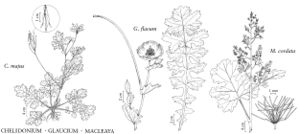Macleaya
in D. Denham and H. Clapperton, Narr. Travels Africa, app., 218. 1826.
| Taxon | Illustrator ⠉ | |
|---|---|---|
 | Macleaya cordata Glaucium flavum Chelidonium majus | John Myers John Myers John Myers |
Herbs, perennial, caulescent, usually glaucous, from rhizomes; sap yellow. Stems hollow, leafy. Leaves alternate, petiolate; blade 1-2× subpalmately or pinnately lobed. Inflorescences terminal, paniculate, many-flowered; bracts present. Flowers: sepals 2, distinct; petals absent; stamens 25-30 [8-12]; pistil 2-carpellate; ovary substipitate, 1-locular; style short; stigma 2-lobed. Capsules nodding, substipitate, 2-valved, dehiscing from apex. Seeds 4-6 [1], arillate [not arillate]. x = 10.
Distribution
North America, Asia (China and Japan)
Discussion
Species 2 (1 in the flora).
Native to temperate eastern Asia, Macleaya has sometimes been merged with neotropical Bocconia, which differs in having perennial stems, long-stipitate ovaries, fleshy, single-seeded capsules dehiscing from the base, and much larger seeds. The sap of Macleaya has been used in traditional Chinese medicine as an antiseptic for wounds (C. Grey-Wilson 1993).
Selected References
None.